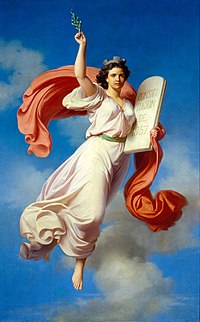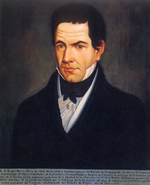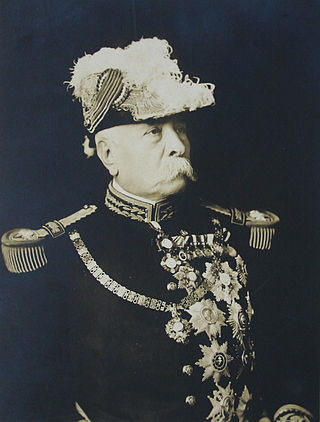
José de la Cruz Porfirio Díaz Mori, known as Porfirio Díaz, was a Mexican general and politician who served seven terms as President of Mexico, a total of 31 years, from 28 November 1876 to 6 December 1876, 17 February 1877 to 1 December 1880 and from 1 December 1884 to 25 May 1911. The entire period from 1876 to 1911 is often referred to as the Porfiriato, and has been characterized as a de facto dictatorship.

Benito Pablo Juárez García was a Mexican Liberal lawyer and statesman who served as the 26th president of Mexico from 1858 until his death in office in 1872. As a Zapotec man, he was the first indigenous president of Mexico and the first indigenous head of state in the postcolonial Americas. Previously, he had served as Governor of Oaxaca and had later ascended to a variety of federal posts including Secretary of the Interior, Secretary of Public Education, and President of the Supreme Court. During his presidency he led the Liberals to victory in the Reform War and in the Second French intervention in Mexico.
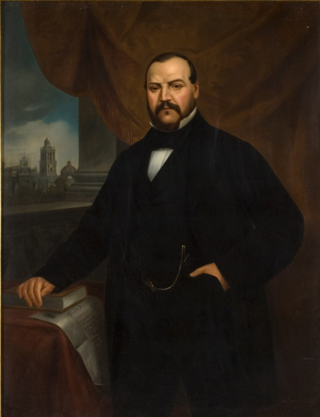
Ignacio Gregorio Comonfort de los Ríos, known as Ignacio Comonfort, was a Mexican politician and soldier who was also president during La Reforma.

Manuel del Refugio González Flores was a Mexican military general and liberal politician who served as the 35th President of Mexico from 1880 to 1884.

Sebastián Lerdo de Tejada y Corral was a Mexican liberal politician and jurist who served as the 27th president of Mexico from 1872 to 1876.

Miguel Lerdo de Tejada was a Mexican statesman, a leader of the Revolution of Ayutla, and author of the Lerdo Law, extinguishing the right of corporations, including the Roman Catholic Church and indigenous communities, from holding land.

In the history of Mexico, La Reforma, or reform laws, refers to a pivotal set of laws, including a new constitution, that were enacted in the Second Federal Republic of Mexico during the 1850s after the Plan of Ayutla overthrew the dictatorship of Santa Anna. They were intended as modernizing measures: social, political, and economic, aimed at undermining the traditional power of the Catholic Church and the army. The reforms sought separation of church and state, equality before the law, and economic development. These anticlerical laws were enacted in the Second Mexican Republic between 1855 and 1863, during the governments of Juan Álvarez, Ignacio Comonfort and Benito Juárez. The laws also limited the ability of Catholic Church and indigenous communities from collectively holding land. The liberal government sought the revenues from the disentailment of church property, which could fund the civil war against Mexican conservatives and to broaden the base of property ownership in Mexico and encouraging private enterprise. Several of them were raised to constitutional status by the constituent Congress that drafted the liberal Constitution of 1857. Although the laws had a major impact on the Catholic Church in Mexico, liberal proponents were not opposed to the church as a spiritual institution, but rather sought a secular state and a society not dominated by religion.
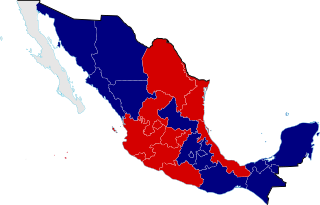
The Reform War, or War of Reform, also known as the Three Years' War, and the Mexican Civil War, was a complex civil conflict in Mexico fought between Mexican liberals and conservatives with regional variations over the promulgation of Constitution of 1857. It has been called the "worst civil war to hit Mexico between the War of Independence of 1810-21 and the Revolution of 1910-20." Following the liberals' overthrow of the dictatorship of conservative Antonio López de Santa Anna, liberals passed a series of laws codifying their political program. These laws were incorporated into the new constitution. It aimed to limit the political power of the executive branch, as well as the political, economic, and cultural power of the Catholic Church. Specific measures were the expropriation of Church property; separation of church and state; reduction of the power of the Mexican Army by elimination of their special privileges; strengthening the secular state through public education; and measures to develop the nation economically.

The Plan of Ayutla was the 1854 written plan aimed at removing conservative, centralist President Antonio López de Santa Anna from control of Mexico during the Second Federal Republic of Mexico period. Initially, it seemed little different than other political plans of the era, but it is considered to be the first act of the Liberal Reform in Mexico. It was the catalyst for revolts in many parts of Mexico, which led to the resignation of Santa Anna from the presidency, never to vie for office again. The next Presidents of Mexico were the liberals, Juan Álvarez, Ignacio Comonfort, and Benito Juárez. The new regime would then proclaim the 1857 Mexican Constitution, which implemented a variety of liberal reforms.
In Mexican history, a plan was a declaration of principles announced in conjunction with a rebellion, usually armed, against the central government of the country. Mexican plans were often more formal than the pronunciamientos that were their equivalent elsewhere in Spanish America and Spain. Some were as detailed as the United States Declaration of Independence. Some plans simply announced that the current government was null and void and that the signer of the plan was the new president.

José María Iglesias Inzáurraga was a Mexican lawyer, professor, journalist and liberal politician. He is known as author of the Iglesias law, an anticlerical law regulating ecclesiastical fees and aimed at preventing the impoverishment of the Mexican peasantry.
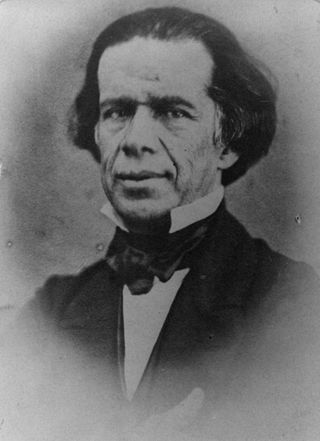
Melchor Ocampo was a Mexican lawyer, scientist, and politician. A mestizo and a radical liberal, he was fiercely anticlerical, perhaps an atheist, and his early writings against the Catholic Church in Mexico gained him a reputation as a leading liberal thinker. Ocampo has been considered the heir to José María Luis Mora, the premier liberal intellectual of the early republic. He served in the administration of Benito Juárez and negotiated a controversial agreement with the United States, the McLane-Ocampo Treaty. The Mexican state where his hometown of Maravatío is located was later renamed Michoacán de Ocampo in his honor.
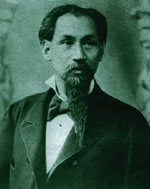
Juan Ignacio Paulino Ramírez Calzada more commonly known as Ignacio Ramírez was a 19th century Mexican liberal intellectual and statesman. He was known for publishing various newspapers championing progressive causes, and he would often use the pen name El Nigromante,the Necromancer. He served in more than one presidential cabinet and would go on to become president of the supreme court.
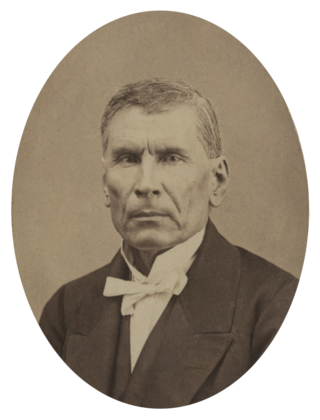
José Santiago Vidaurri Valdez was a controversial and powerful governor of the northern Mexican states of Nuevo León and Coahuila between 1855 and 1864. He was an advocate of federalism.

The Federal Constitution of the United Mexican States of 1857, often called simply the Constitution of 1857, was the liberal constitution promulgated in 1857 by Constituent Congress of Mexico during the presidency of Ignacio Comonfort. Ratified on February 5, 1857, the constitution established individual rights, including universal male suffrage, and others such as freedom of speech, freedom of conscience, freedom of the press, freedom of assembly, and the right to bear arms. It also reaffirmed the abolition of slavery, debtors' prisons, and all forms of cruel and unusual punishment such as the death penalty. The constitution was designed to guarantee a limited central government by federalism and created a strong national congress, an independent judiciary, and a small executive to prevent a dictatorship. Liberal ideals meant the constitution emphasized private property of individuals and sought to abolish common ownership by corporate entities, mainly the Catholic Church and indigenous communities, incorporating the legal thrust of the Lerdo Law into the constitution.
The Liberal Party was a political coalition that emerged in Mexico after independence. Strongly influenced by French Revolutionary thought, and the republican institutions of the United States, it championed the principles of 19th century liberalism, and promoted republicanism, federalism, and anti-clericalism. They were opposed by the Conservative Party.

The Plan of Tacubaya, sometimes called the Plan of Zuloaga, was issued by conservative Mexican General Félix Zuloaga on 17 December 1857 in Tacubaya against the liberal Constitution of 1857. The plan nullified the Constitution while it continued to recognize the election of moderate liberal Ignacio Comonfort as President. Conservatives had fiercely objected to the Constitution of 1857, which abolished special privileges of the Catholic Church and the Mexican Army. President Ignacio Comonfort had not been a strong supporter of the Constitution and joined with Zuloaga, commander of the garrison in Mexico City.

The Lerdo Law was the common name for the Confiscation of Law and Urban Ruins of the Civil and Religious Corporations of Mexico, part of La Reforma. It targeted not only property owned by the Catholic Church, but also properties held in common by indigenous communities and transferred them to private hands. Liberals considered such corporate ownership as a major impediment to modernization and development in Mexico. Drafted by Miguel Lerdo de Tejada, it was signed on 25 June 1856 by President Ignacio Comonfort, but its language was ambiguous, needing subsequent clarifications.
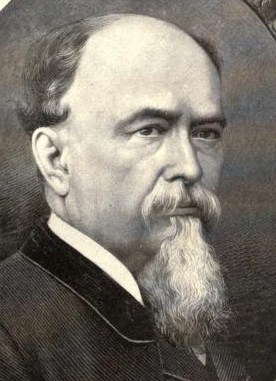
Manuel Romero Rubio, was a Mexican politician and lawyer who participated in the governments of Benito Juárez, Sebastián Lerdo de Tejada and Porfirio Díaz.
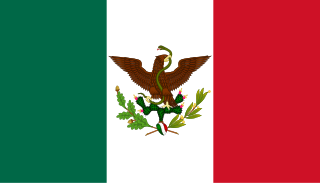
The Restored Republic was the era of Mexican history between 1867 and 1876, starting with the liberal triumph over the Second French Intervention in Mexico and the fall of the Second Mexican Empire and ending with Porfirio Diaz's ascension to the presidency. It was followed by the three-decade dictatorship known as the Porfiriato.
